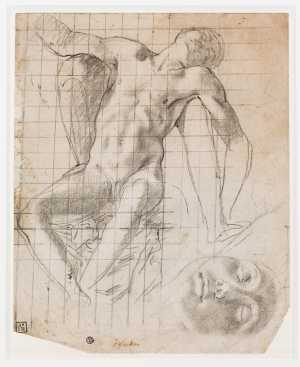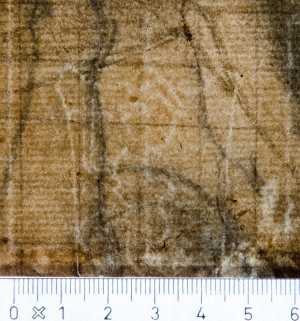Specifications
| Title | Study of a Male Nude for a Pietà |
|---|---|
| Material and technique | Black chalk, heightened with white, squared for transfer |
| Object type |
Drawing
> Two-dimensional object
> Art object
|
| Location | This object is in storage |
| Dimensions |
Width 225 mm Height 279 mm |
|---|---|
| Artists |
Draughtsman:
Andrea Lilio
Previously attributed: Angelo Bronzino |
| Accession number | I 188 recto (PK) |
| Credits | Loan Stichting Museum Boijmans Van Beuningen (former Koenigs collection), 1940 |
| Department | Drawings & Prints |
| Acquisition date | 1940 |
| Creation date | in circa 1596 |
| Watermark | kneeling saint holding a cross, in a shield (large fragment, upper part, 46 x 38 mm, on P5 of 8P, centre of left margin, vV, half folio sheet), similar to Briquet 7628-7629 (resp. Fabriano 1602, Rome 1566), esp. the latter (shield top), none in Piccard Online, similar ones in drawings by Francesco Curradi and Ercole Bazzicaluva in the Fondation Custodia (Byam Shaw 1983, nos. 56 and 66 resp., both 17th-c., WM repr. vol. 2, p. 123) and one by Pierre Monnier, dated 1665-66 in the Yale University Art Galleries (Boorsch/Marciari 2006, no. 54, WM repr. p. 251) [see image] |
| Inscriptions | ‘Allori [possibly ‘Luini’]’ (below centre, pen and brown ink), ‘4x’ (verso, lower left., red chalk), ‘5’ (verso, lower right, pen and brown ink) |
| Collector | Collector / Franz Koenigs |
| Mark | J. Reynolds (L.2364), E. Wauters (L.911), F.W. Koenigs (L.1023a) |
| Provenance | Sir Joshua Reynolds (1723-1792, L.2364)*, London; - ; Emile Wauters (1846-1933, L.911), Paris; his sale, Amsterdam (Muller) 15-16.06.1926, lot 9 (Bronzino, Fl 490 to R.W.P. de Vries); Franz W. Koenigs (1881-1941, L.1023a), Haarlem, acquired in 1926 (Angelo Bronzino); D.G. van Beuningen (1877-1955), Rotterdam, acquired with the Koenigs Collection in 1940 and donated to Stichting Museum Boijmans Van Beuningen |
| Exhibitions | Amsterdam 1934, no. 504 (Bronzino); Paris 1935, no. 528; Rotterdam/New York 1990, no. 70; Rotterdam 2009 (coll 2 kw 2) |
| Internal exhibitions |
Van Pisanello tot Cézanne (1992) De Collectie Twee - wissel II, Prenten & Tekeningen (2009) |
| Research |
Show research Italian Drawings 1400-1600 |
| Literature | Lees 1913, p. 87, fig. 99 (Bronzino); Vasari Society 1920-35, vol. 11 (1930), pp. 124-25, pl. 2-D (Bronzino); Paris 1935, no. 528, pl. 34; Berenson 1938, no. 604 B, fig. 1002 (Bronzino); Berenson 1961, p. 117, no. 605 D-1 (Bronzino); Luijten/Meij 1990, no. 70, ill., fig. 1 (verso); Ward Nelson 1991, p. 187, pl. 3-4; Cellini 1992, p. 99; Di Giampaolo 1995, pp. 77-79; Pulini 2001, pp. 51, 57, 63, fig. 6; Pulini 2003, no. 7, pp. 197-199, ill.; Agenda 2013, no. 7, ill. |
| Material | |
| Object | |
| Technique |
Highlight
> Painting technique
> Technique
> Material and technique
|
| Geographical origin | Italy > Southern Europe > Europe |
Do you have corrections or additional information about this work? Please, send us a message


























